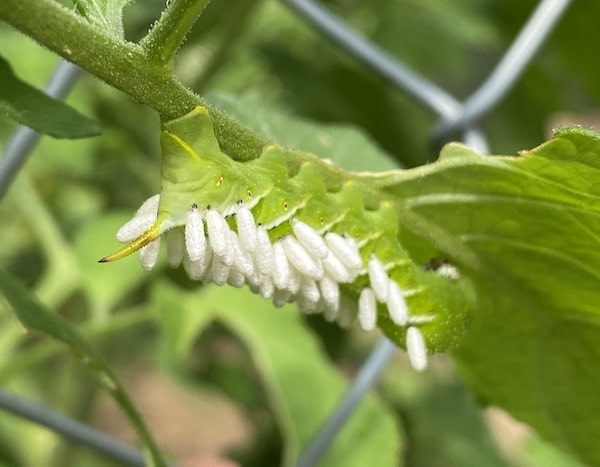Updated: June 22, 2022
Beneficial insects are increasing in my garden every year. How do I know? I find more and more tomato hornworms impregnated by parasitic wasps every summer.
Let’s take a sec to get the legal words out of the way. This article may contain affiliate links. That means if you click and buy from my partners, I will make a tiny amount of money at no cost to you. This in no way affects my recommendations.
Typically, I grow about 15 tomato plants. Mostly, Brandywine and Pineapple tomatoes. This year I found 7 impregnated hornworms. Each year there are more.
It’s no coincidence that they are increasing. That’s because I decided to let the south side hill by the garden go un-mowed.

The dirt on the hill was eroding. So I thought it would be best to let the weeds grow to better hold the soil.
I also planted wildflowers to attract beneficial insects and make it look attractive. The plan was to cut it back in the late fall to avoid having trees grow so near to the house.
There seemed to be thousands of predators, prey and pollinators even though there were few if any before.
— Suburban Hobby Farmer
To my surprise, it attracted far more beneficial bugs than I expected.
But it wasn’t because I purchased and seeded wildflowers. It was because the native wildflowers flourished.
Queen Anne’s lace, milkweed, yarrow, fleabane daisy, goldenrod, New England aster and others all did reasonably well in the poor soil on the hill.
Ladybugs, tachinid flies, lacewings and parasitic wasps
It was the native plants that attracted a very wide variety of pollinators – many bee types I didn’t know existed – as well as many predators including ladybugs, tachinid flies, lacewings, and a variety of parasitic wasps.
The hill became a hot bed of insect activity. There seemed to be thousands of predators, prey and pollinators even though there were few if any before the weeds sprung up.
For me it was fascinating watching all the different insects go about their business. I was especially pleased when, for example, I saw a ladybug larva munching on some aphids or a lacewing flying away with a helpless bug.
Here’s a YouTube video that shows a hornworm with parasitic wasps about to emerge.
A good book to help you identify good and bad bugs in your garden is Rodale’s Insect, Disease & Weed I.D. Guide: Find-It-Fast Organic Solutions for Your Garden.
Buying beneficials not the answer
Before this year, I was leaning towards buying beneficial insects, e.g., blue mason bees, to help with pollinating my apple trees and ladybugs to help with controlling aphids.
Now I’ve realized that adding beneficial insects to the garden is not the answer. Beneficials were not missing from my garden.
What I truly needed was to restore the balance in the environment by making sure that the proper habitat was available. I didn’t even need to buy seeds. The weed seeds were already there.
The beneficials I would have bought probably wouldn’t have stuck around anyway.
Then again, maybe I’m just lucky to live in an almost rural part of Southern New Hampshire where there’s still a variety of insects living close by.
Related articles that might interest you:
1. Nine Ideas for Zero Waste Gardening
2. Five Tips for Starting Seeds More Cheaply
3. Seven Money-saving Garden Tips
4. Guide to Four Rain Barrel Downspout Diverters
Suburban Hobby Farmer is a participant in the Amazon Services LLC Associates Program, an affiliate advertising program designed to provide a means for sites to earn advertising fees by advertising and linking to amazon.com.